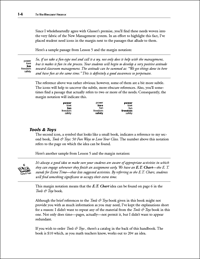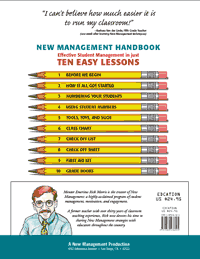

![]()
Goals for this lesson:
-
Become familiar with the symbols used in this book.
-
Discover that there's a contents guide on the back cover of this handbook.
-
Figure out how your individual teaching situation affects the way in which you'll use some of the ideas in this book.
-
Learn ways to find help when you need it.
-
Make a commitment to be reasonable about how many new techniques you can successfully incorporate at one time.
Sample Page
Just click on the page image to see the page in PDF format.

Back cover contents
Since the one of the goals listed above mentioned the back cover of the book, I thought it would make sense to show what it looked like.

The ten pencils represent the ten different lessons. Each pencil has the title of one of the lessons printed on it. Having the lesson titles on the back cover eliminates the need to search for the Table of Contents when you're quickly trying to find a lesson.
Frequently asked questions
There are a number of FAQ's in the appendix of the book. Since they have been organized by lesson, I figured it might help to have those questions--and my answers--at the bottom of each lesson page. So here goes.
![]()
FAQ Lesson 1
You mentioned Bill Glasser's book, The Quality School Teacher. Should I read it?
Once you've finished reading this one, have at it. It's a good book with some deep insight and well worth reading if you've got the time. You should know, though, that its primary audience is the inner-city high school teacher.
If you're looking for a great book on discipline, read Robert MacKenzie's Setting Limits in the Classroom. It is without a doubt the best book I've ever read on discipline and will literally change the way you interact with your students.
Here are some other books worth reading:
Between Teacher and Child, Haim Ginott (a classic)
Dumbing Down Our Kids, Charles J. Sykes
Right-Brained Children in a Left-Brained World, Jeffrey Freed
Dibs: In Search of Self, Virginia M. Axline
The Bible
I read in this lesson that you offer New Management workshops. How can I attend one?
The best way to go is to have me come to your school or district and conduct one. For this to happen, though, you'll have to be the one to pass along the information to your administrators. We do very little promotion or marketing ourselves; it's all done by teachers who have attended workshops that I present at conferences or through university extension courses. If you'd like a brochure that you can share with your administrator, just email me--rick@newmanagement.com--and I'll send you one.
If you'd like to find out how you can attend one by yourself without involving your school or district, check out the New Management website (www.newmanagement.com) and click on the One-Day Seminars link. You'll be shown a list of offerings, dates, and locations that are open to anyone who wishes to attend. It's not an extensive list because most of the workshops are contracted by schools and districts and are limited to just their staff members.
My current teaching position doesn't match any of the ones you described on page 1-8. It's completely different. What do I do?
Do what you can. Not every idea is going to work in every classroom. One of the beauties of teaching, though, is that you can modify new ideas to fit your needs and the needs of your students.
Here's something you might want to keep in mind: Teaching positions sometimes change over time. Ideas you may not be able to use in your current position might come in handy later on when switch to a new one. In other words, keep this handbook in a safe spot. You just never know when you're going to find yourself facing a brand new teaching situation.
I am team-teaching with another teacher. We share students and lesson responsibilities. Unfortunately, my partner does not want to use the student number system. What can I do?
Even though your partner is not yet ready to go with the New Management system, don't feel you need to limit yourself. Apply the ideas you've learned to your core group of students. The benefits you'll gain from using the system with just those students will be well worth the time you spend developing it.
Also, there's a really good chance that, within a month or so, your partner will begin to see the light. More than the words you could use to convince your teammate that it's a great program will be your nonverbal enthusiasm of its merits and the ease of management you'll be able to display.
Spiral-bound teacher's guides or manuals in 3-ring binders are so much easier for me to use. How come you didn't use either of those formats?
Cost, shipping concerns, and binder quality were the main issues.
However, the redeeming value of a paperback book--such as this one--is that you can easily turn it into a spiral-bound book or one that fits in a 3-ring binder on your own.
Check out page 1-13 for suggestions on how to do this.
I teach at the secondary level. Many teachers are already using the number system. Won't the students get confused by having different numbers for each class?
It's actually no harder for them to keep the different numbers separate than it is for them to remember the different rooms in which the classes are conducted. It's one of those it-takes-a-bit-of-time things. Also, they'll have a notebook in which to record their student number information, and you'll have a roster of names and numbers on the wall as a reference tool.
If you've decided to go with using colors to help keep your classes organized--page 1-11--I think your students will find it even easier to stay on top of things.
